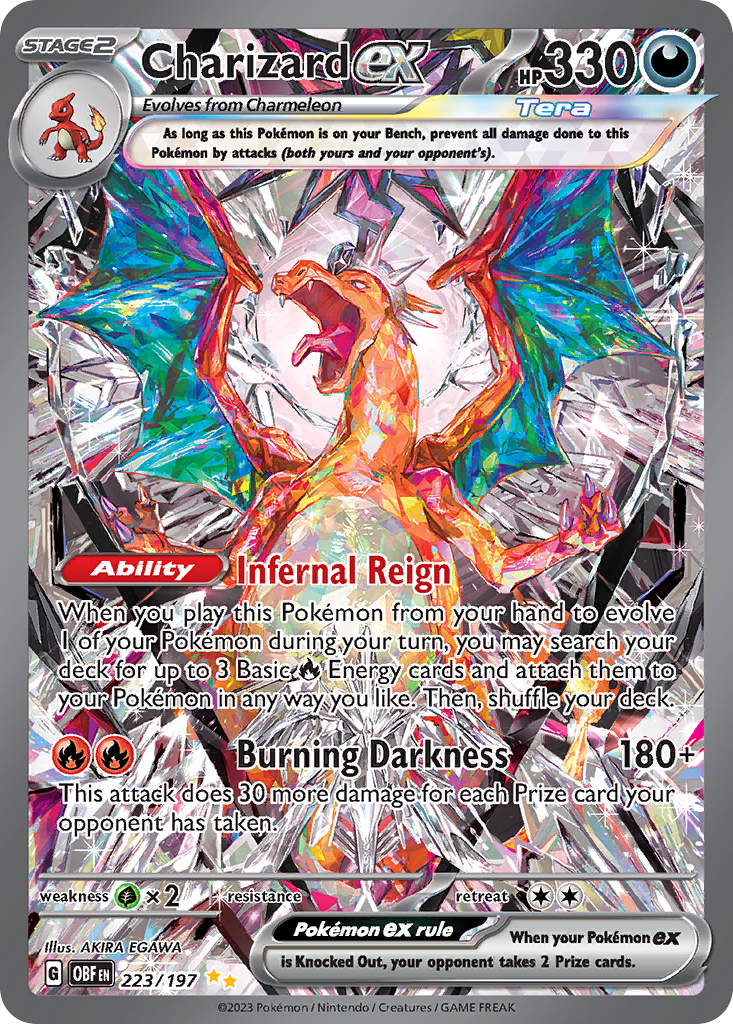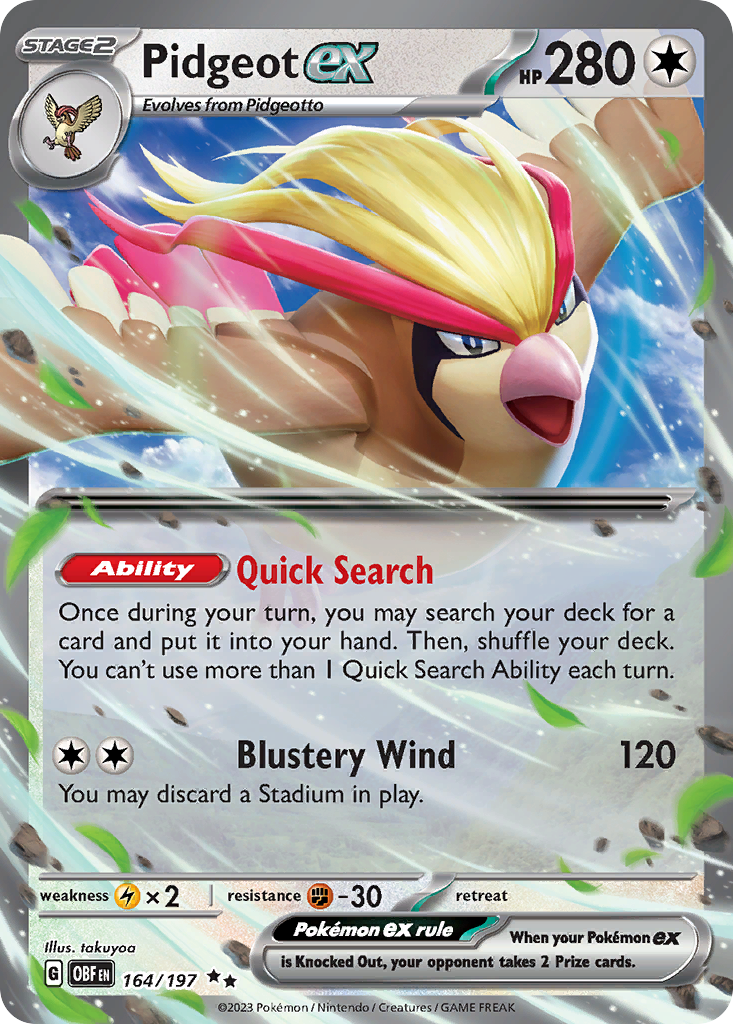Flame of Many Colors — The Variants of Charizard ex
Hello everyone! I’ve recently returned from my brief Pokemon hiatus, and I’m excited to be back, particularly as we begin the 2024 season! As I apparently wasn’t content enough to simply visit for the World Championships, I recently moved across the seas to Japan, where I will now reside for the foreseeable future. What this means for you all is that my content will now come from a slightly different perspective than my previous vantage point as a player in the US Midwest.
As a player, I’ve always kept a close eye on developments in the Japanese metagame as a way to stay on top of things when we get each new set; now that I’ll be in the thick of that metagame, I’ll be able to give you all a firsthand account of how the newest cards are expected to impact the format. Here in Japan, we’re slightly ahead of the western set release schedule; however, the only set that we have exclusively is 151, which hasn’t been all that impactful in terms of the overall metagame. In addition, the release order of 151 and Ruler of the Black Flame was the opposite here in Japan (that is, 151 came out first), and as a result, there’s only been about a two-week headstart on the format here compared to everywhere else. While the Japanese meta typically differs a little bit from the non-Japanese meta, the early results from both regions show a similar direction in terms of the metagame. However, while there hasn’t been much of a lead, those two extra weeks have helped to establish a bit more refinement here, which we can use to our advantage.
When it comes to the cards in Obsidian Flames, most are unfortunately not all that competitive. The trainers are lackluster, and quite a few of the Pokemon ex came from the Japanese ex Starter Decks, which are Starter Deck levels of playability, which is to say, not great. The Pokemon ex that were from Ruler of the Black Flame are thankfully stronger, and a couple of those have been seeing play. Glimmora ex and Tyranitar ex are niche archetypes, but will pop up occasionally, and Revavroom ex is a neat card that can potentially bring back the fun Tool Drop archetype.
However, if we’re looking for something more competitive, there are only two cards that I feel comfortable saying will certainly have an impact in the meta: Pidgeot ex and Charizard ex. Pidgeot ex has one of the best consistency-oriented Abilities ever printed, and it is sure to show up in decks that already play Rare Candy, as its effect is strong enough to be well worth the inclusion. As for Charizard ex, it has quickly become a top-tier archetype, both on its own and as a tech line in conjunction with other attackers. Its meta share has been high, and the deck has been getting results, even though the decklists are in an early, unrefined state. As players continue to develop this deck, I would expect its winning percentage to improve even more, and given its popularity both here in Japan and abroad, I don’t think it’ll take too long for a strong list to disseminate. In this article, I’m going to be taking a look at this new Charizard ex archetype, and show you both what I’ve put together as a strong “normal” Charizard ex list and some alternate ways to use Charizard that you might not expect!
Charizard ex / Pidgeot ex
To start things off, let’s take a look at the more normal list. While Charizard ex can work in quite a few ways, the most popular build has been a straightforward combination of Charizard ex and Colorless consistency Pokemon. Specifically, folks have been playing it with Arceus VSTAR and that new Pidgeot ex that I hyped up in the previous paragraph. Arceus VSTAR is mostly used for Starbirth; it isn’t a great attacker, and since your other cards are Pokemon ex, you can’t actually take advantage of Trinity Nova’s Energy acceleration. Starbirth, however, can be worth the space, as it allows you to find Rare Candy, which you need to set up your Pokemon ex. The most common Starbirth use is to find a Rare Candy and Pidgeot ex, after which you can use Quick Search every turn. Quick Search seems to be as good now as it was back in 2006, especially in a Rare Candy–reliant archetype like this one. Being able to search for a Rare Candy every turn makes getting Charizard ex into play rather easy, and once you are set up, you can use Quick Search to find whatever you might need, be it a Supporter, a specific Tool or Item, or a niche one-of tech. Not only does Quick Search increase your consistency, it also allows your deck design to include far more situational one-of cards, since you can find them whenever you are in the situation where you would need them.
Charizard ex is typically the only attacking Pokemon in this build. Players have occasionally included one-of alternate attackers such as Victini ex, Entei V, or my preferred choice Delphox V, but Charizard ex will still be the attacker for most of the match. As an attacker, Charizard ex starts off at a similar level to Pokemon like Arceus VSTAR, in that it can 2HKO things, but won’t get a lot of OHKOs. As the game goes on, however, Charizard ex’s damage continues to rise, to the point that in the late game, Burning Darkness will OHKO pretty much everything. At that point, Charizard ex has a big advantage, in large part thanks to its high HP. At 330, not much can OHKO Charizard ex, and even when your opponent does get a KO, they only get two Prizes, not the three they would get from KOing a comparably tough VMAX.
In that sense, this deck has a rather straightforward strategy: trade KOs in the early game, then take advantage of a positive Prize trade in the late game. The stats that Charizard ex has give it an advantage in a lot of matchups, and the consistency of Quick Search allows it to be adaptable throughout the game. I’ve seen quite a few lists for this kind of Charizard ex deck both here and abroad, and a lot seem to make a few mistakes: namely, not including enough Pokemon search and not including enough counter Stadiums. This list dodges those pitfalls, and includes a bit of spiciness to help deal with certain situations. Here’s the list:
This concludes the public portion of this article.
If you'd like to continue reading, consider purchasing a PokeBeach premium membership! If you're not completely satisfied with your membership, you can request a full refund within 30 days.
Each week we post high-quality content from some of the game's top players. Our article program isn't a corporate operation, advertising front, or for-profit business. We set our prices so that we can pay the game's top players to write the best content for our subscribers. Each article topic is carefully selected, goes through multiple drafts, and is touched up by our editors. We take great pride in our program!



